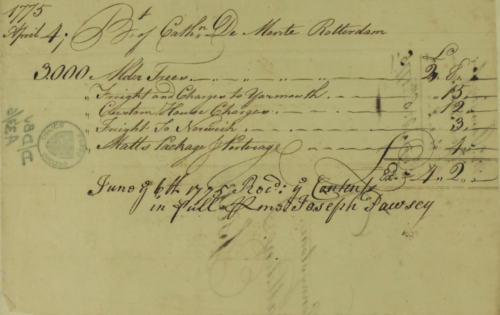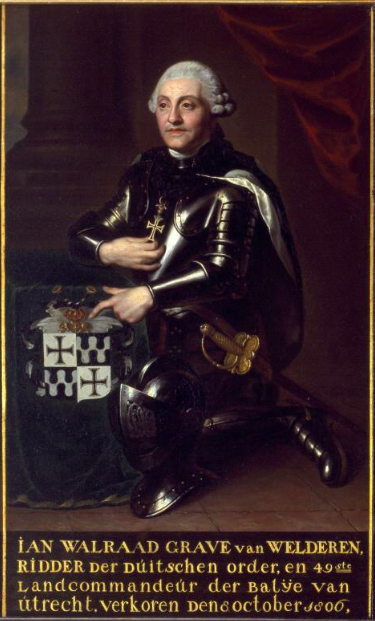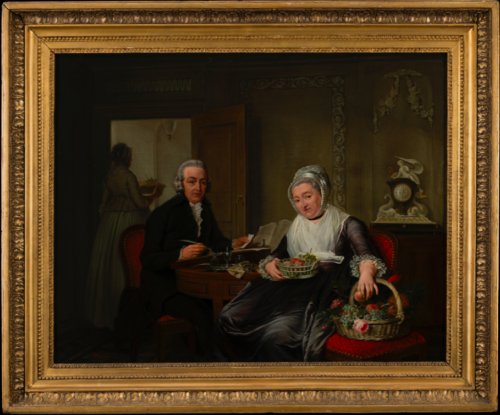‘Sir John clearly had his continental sources’, Jane Brown wrote in 2011, specifically referring to a purchase of ‘3,000 Dutch alders from Rotterdam’.1Jane Brown, Lancelot ‘Capability’ Brown. The Omnipotent Magician 1716-1783 (London 2011), p170. Brown implied that Audley End owner Sir John Griffin Griffin may have deviated from designer Lancelot Brown’s planting intentions. But these plants were bought in 1775, long after Lancelot Brown had left Audley End in 1768 after a quarrel about operations and progress.2J.D. Williams, Audley End. The Restoration of 1762 – 1797, Essex Record Office publications, No. 45 (Chelmsford 1966), p46, footnote 27. At the time Joseph Hicks oversaw work on the new layout, probably adhering to the original Brown plan. In 1966, J.D. Williams added the word ‘Dutch’ to the transaction (the bill just says ‘3.000 Alder Trees’), but he also provided the name of their supplier: ‘a certain Catherine de Monte of Rotterdam.'3Scan of the bill courtesy of Essex Record Office; D/DBy A33/6, Audley End estate, Household and Estate Papers 1775.

Her Rotterdam roots sparked my interest. Who was she? What was her role in this transaction? Were these plants purchased from her for a specific reason? Could she have been the continental source of plants for John Griffin Griffin? That may have been the case, but since his brother-in-law was Dutch, ‘Sir John’ was possibly spoilt for choice. Here’s a look at these most likely ‘continental sources’.
Jan Walraad van Welderen
In May 1759, Jan Walraad van Welderen married Ann Whitwell in The Hague.4Essex Record Office holds a 1770 copy of their marriage settlement: D/Dby F34A. She had been a courtier of Anne of Hannover (widow of stadtholder Willem IV and George II’s eldest daughter), who had recently passed away. Ann Whitwell was also Sir John’s younger sister: he went by the surname Whitwell till 1748, when a petition to change his name from John (Griffin) Whitwell to John Griffin Griffin was passed by the House of Lords.5Journal of the House of Lords Volume 27, 1746-1752 (London, 1767-1830), pp. 251-257 (source: British History Online). Van Welderen and his family travelled to London in the Autumn of 1762, where he was appointed ambassador for the States General of the United Provinces of the Netherlands. He remained in that position till 1780, when he was called back because of the 4th Anglo-Dutch war (1780-1784). Van Welderen stayed in the Dutch Republic for the next one and a half decade, till a combination of his wife’s death and the pro-French, anti-Orangist Batavian Revolution drove him back to England in 1796. He lived at 16 Saville Row in London when he died in 1807.6See ‘Cork Street and Savile Row Area: Table of notable inhabitants on the Burlington Estate.’ Survey of London: Volumes 31 and 32, St James Westminster, Part 2. Ed. F H W Sheppard. London: London County Council, 1963. 566-572. British History Online. Web. 11 October 2020. http://www.british-history.ac.uk/survey-london/vols31-2/pt2/pp566-572.

At the very end of his life (1806) Van Welderen was elevated to the position of Land Commander of the Bailiwick of Utrecht of the Teutonic Order, a Protestant branch of the Roman Catholic Deutscher Orden.7He’d been a member of the order since at least 1766. In July 2017 Audley End had two portraits of Van Welderen on display, where he is wearing a so-called ‘Malteze cross’. Though there is more than one similarity, Van Welderen’s cross pattéé probably should be identified as the cross of this Teutonic order.8He was portrayed in 1808, after his death, as Land Commander in a range with his peers in the collections of the Duitse Orde. It was painted by Pieter Christoffel Wonder (1777-1852).
Referred to as Count Welderen or Comte de Welderen during his professional life, he is identified at Audley End as ‘John Walrond, Comte de Welderen‘, an anglicised version of his name that goes back to a history of Audley End, published in 1836.9Richard Lord Braybrooke, The history of Audley End. To which are appended notices of the town and parish in the county of Essex (London 1836), p129. An epitaph or plaque with memorial inscriptions devoted to the Griffin-Whitwell family, once located in the now demolished St. James’s Church on Hampstead Road (London) referred to him as ‘(…) another brother-in-law of Lord Howard de Walden, the Count of Walderen, Ambassador from the States General to Great Britain (1762–1780) who married Anne Whitwell, (d. 1807)‘.10‘St. James Church, Hampstead Road’, in Survey of London: Volume 21, the Parish of St Pancras Part 3: Tottenham Court Road and Neighbourhood, ed. J R Howard Roberts and Walter H Godfrey (London, 1949), pp. 123-136. British History Online http://www.british-history.ac.uk/survey-london/vol21/pt3/p123-136.
Jan Walraad van Welderen is hardly known at home. He is credited for persuading the Mozart family, who were on their way back home from London in 1765, to make a detour via the court in The Hague.11Piet Verwijmeren, Mozart op reis. De tournee van een wonderkind, 1763-1766 (Zutphen 2005), p136-137. Alternatively see W. Lievense, De familie Mozart op bezoek in Nederland (Hilversum 1965), p12. He was a close continental source for Sir John but is not known for his personal interest in trade, gardens or plants, and therefore not a likely mediator for this transaction.
Catharin Mary de Monté
Catharin Mary de Monté was directly involved with the transport of alders from Rotterdam, so much is certain.12The spelling of her first name here is based on how she was baptized, but seems neither Dutch or English. Since her name on the bill was shortened as Cathn de Monte, it appears she didn’t use the letter ‘e’ at the end of her name herself. Use of the accent on the letter ‘e’ in their last name was inconsistent but would increase towards the end of the eighteenth century. Catharin was born in Rotterdam as the daughter of Johannes de Monté and Lucretia (Lucy) Lombe. He was born in Batavia (now Jakarta) in the Dutch East Indies, she was born into a family of silk merchants in Norwich, where the couple got married in 1743. Following Johannes and Lucy to Rotterdam was her brother Thomas, who from 1746 onwards would be clerk in their companies.13The firm operated under the names Fa. John de Monté; Fa. John de Monte & Comp; and later Firma Demonte & Van Bazel. In 1752 Thomas Lombe was granted permission by Johannes de Monté to venture out into the world. In Dutch: ‘betuigt, dat de sterke genegentheit van den voorn~ Thomas Lombe om vreemde landen te bezigtigen hem Compt [JdM] alleen heeft doen resolveren aan denselven zijne dismissie te verlenen.’ (Stadsarchief Rotterdam, Oud Notarieel Archief, inv.nr. 2817, p386, deed dated 13 april 1752). After her husband’s death in 1755, Lucy Lombe continued the business under the name Wede Monté & Van Bazel, arranging transports to and from British ports.14The Teesside area often occurs in their shipping contracts. A merchant called Dowson or Dawson, from Yarm near Stockton-on-Tees, is mentioned. Living in Rotterdam, Lucy Lombe remained attached to her native land. The Lombe family owned several properties in Norfolk and some of these passed into her hands, for example near Swanton Morley and in (Great) Yarmouth. In Rotterdam she could attend two churches that served the English community and at some stage Lucy bought herself a Holy Bible, printed in 1755.15Now kept in the Verloren family archive in Alkmaar, Westfries Archief, toegang 1535, inv.nr. 657. The same archive holds a Holy Bible dated 1772, which probably belonged to her son Johan Philip de Monté (1754-1814), inv.nr. 665.

Catharin’s contribution to the business remains unclear, but this bill indicates she played an active role. Catharin never had children, and she waited till a year after her mother’s death to marry widower Adrianus Cornelis Oudorp, at the age of 49.16On the 30th of March 1795. She died six years later, a year after this charming family portrait was made.17Painting dated in 1800 by Nicolaes Muys (1740-1808), currently in the collection of Museum Rotterdam, on loan from the Westfries Museum in Hoorn.
The family business seems to have shipped anything between ports in the wider North Sea region. From what can be gleaned from the little evidence that remains, they didn’t specialise in plants or other ‘fresh’ goods. Their papers also don’t show they owned any nurseries, or fields where alders could be grown. The De Montés probably considered these plants as just another tradable commodity, an easy sale that brought cash in their pockets.
Having identified and dismissed these two ‘continental sources’ a question comes to mind: did Sir John Griffin Griffin really need such sources for a purchase like this, or could he rely on a well established trade connection between Rotterdam and Great Yarmouth? Read more about that in part 2.
Footnotes
| ↑1 | Jane Brown, Lancelot ‘Capability’ Brown. The Omnipotent Magician 1716-1783 (London 2011), p170. |
|---|---|
| ↑2 | J.D. Williams, Audley End. The Restoration of 1762 – 1797, Essex Record Office publications, No. 45 (Chelmsford 1966), p46, footnote 27. |
| ↑3 | Scan of the bill courtesy of Essex Record Office; D/DBy A33/6, Audley End estate, Household and Estate Papers 1775. |
| ↑4 | Essex Record Office holds a 1770 copy of their marriage settlement: D/Dby F34A. |
| ↑5 | Journal of the House of Lords Volume 27, 1746-1752 (London, 1767-1830), pp. 251-257 (source: British History Online). |
| ↑6 | See ‘Cork Street and Savile Row Area: Table of notable inhabitants on the Burlington Estate.’ Survey of London: Volumes 31 and 32, St James Westminster, Part 2. Ed. F H W Sheppard. London: London County Council, 1963. 566-572. British History Online. Web. 11 October 2020. http://www.british-history.ac.uk/survey-london/vols31-2/pt2/pp566-572. |
| ↑7 | He’d been a member of the order since at least 1766. |
| ↑8 | He was portrayed in 1808, after his death, as Land Commander in a range with his peers in the collections of the Duitse Orde. It was painted by Pieter Christoffel Wonder (1777-1852). |
| ↑9 | Richard Lord Braybrooke, The history of Audley End. To which are appended notices of the town and parish in the county of Essex (London 1836), p129. |
| ↑10 | ‘St. James Church, Hampstead Road’, in Survey of London: Volume 21, the Parish of St Pancras Part 3: Tottenham Court Road and Neighbourhood, ed. J R Howard Roberts and Walter H Godfrey (London, 1949), pp. 123-136. British History Online http://www.british-history.ac.uk/survey-london/vol21/pt3/p123-136. |
| ↑11 | Piet Verwijmeren, Mozart op reis. De tournee van een wonderkind, 1763-1766 (Zutphen 2005), p136-137. Alternatively see W. Lievense, De familie Mozart op bezoek in Nederland (Hilversum 1965), p12. |
| ↑12 | The spelling of her first name here is based on how she was baptized, but seems neither Dutch or English. Since her name on the bill was shortened as Cathn de Monte, it appears she didn’t use the letter ‘e’ at the end of her name herself. Use of the accent on the letter ‘e’ in their last name was inconsistent but would increase towards the end of the eighteenth century. |
| ↑13 | The firm operated under the names Fa. John de Monté; Fa. John de Monte & Comp; and later Firma Demonte & Van Bazel. In 1752 Thomas Lombe was granted permission by Johannes de Monté to venture out into the world. In Dutch: ‘betuigt, dat de sterke genegentheit van den voorn~ Thomas Lombe om vreemde landen te bezigtigen hem Compt [JdM] alleen heeft doen resolveren aan denselven zijne dismissie te verlenen.’ (Stadsarchief Rotterdam, Oud Notarieel Archief, inv.nr. 2817, p386, deed dated 13 april 1752). |
| ↑14 | The Teesside area often occurs in their shipping contracts. A merchant called Dowson or Dawson, from Yarm near Stockton-on-Tees, is mentioned. |
| ↑15 | Now kept in the Verloren family archive in Alkmaar, Westfries Archief, toegang 1535, inv.nr. 657. The same archive holds a Holy Bible dated 1772, which probably belonged to her son Johan Philip de Monté (1754-1814), inv.nr. 665. |
| ↑16 | On the 30th of March 1795. |
| ↑17 | Painting dated in 1800 by Nicolaes Muys (1740-1808), currently in the collection of Museum Rotterdam, on loan from the Westfries Museum in Hoorn. |


